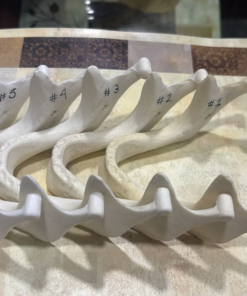Description
Transparent Lower Extremity Muscles Model – Detailed Anatomy Learning Tool
The Transparent Lower Extremity Muscles Model is a life-sized anatomical model designed to showcase the detailed muscle structure of the human lower extremities.
It offers a clear, unobstructed view of the major muscles of the hip, thigh, calf, and foot, making it an ideal educational tool for medical professionals, students, and educators.
Key Features of the Transparent Lower Extremity Muscles Model
Hip Muscles
-
Iliopsoas
-
Gluteus maximus
-
Gluteus medius
-
Gluteus minimus
-
Tensor fasciae latae
-
Piriformis
Thigh Muscles
Quadriceps Group
-
Rectus femoris
-
Vastus lateralis
-
Vastus medialis
-
Vastus intermedius
Hamstring Group
-
Biceps femoris
-
Semitendinosus
-
Semimembranosus
Adductor Group
-
Adductor magnus
-
Adductor longus
-
Adductor brevis
-
Gracilis
Calf Muscles
-
Gastrocnemius
-
Soleus
-
Tibialis posterior
-
Flexor digitorum longus
-
Flexor hallucis longus
-
Peroneus longus
-
Peroneus brevis
Foot Muscles
-
Flexor digitorum brevis
-
Abductor hallucis
-
Flexor hallucis brevis
-
Adductor hallucis
-
Quadratus plantae
-
Lumbricals
-
Dorsal interossei
-
Plantar interossei
Educational Benefits
This transparent anatomical model allows for a comprehensive study of lower limb muscle structure, showing how each muscle contributes to movements of the hip, knee, ankle, and foot.
It also provides insight into how these muscles work together to maintain lower body strength, flexibility, and stability.
The transparency of the model gives learners a unique perspective on the spatial relationships between muscle layers and surrounding anatomical structures.
This makes it especially useful for:
-
Medical school anatomy courses
-
Physiotherapy and sports science education
-
Clinical demonstrations
-
Patient education in rehabilitation settings
Why Choose the Transparent Lower Extremity Muscles Model?
-
Life-sized accuracy for realistic study
-
Detailed labeling for clear identification
-
Durable construction for repeated use
-
Versatile applications in classrooms, clinics, and labs
Conclusion
The Transparent Lower Extremity Muscles Model is more than just a teaching aid—it’s a valuable resource for anyone studying or working with human anatomy.
By providing a clear view of the muscles of the hip, thigh, calf, and foot, it enhances understanding of functional anatomy and supports effective medical and educational training.


Reviews
There are no reviews yet.